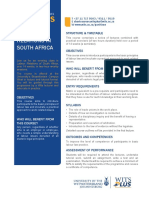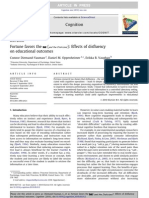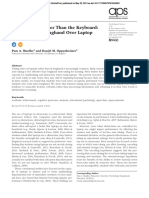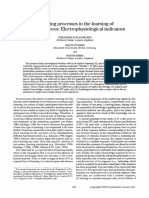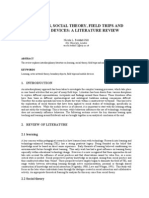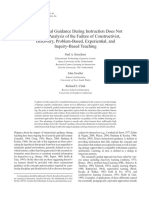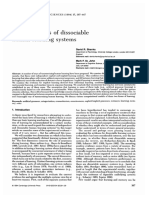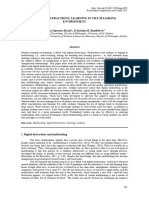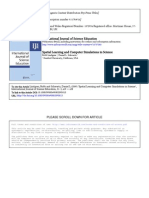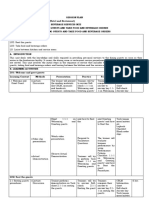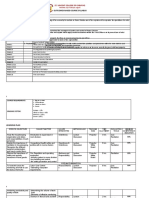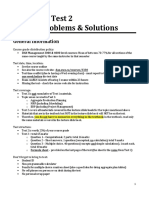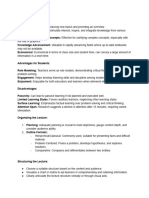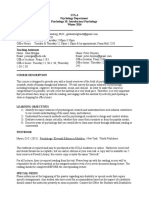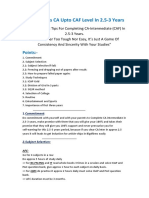The Laptop and The Lecture The Effects of Multitasking in Learning Environments
The Laptop and The Lecture The Effects of Multitasking in Learning Environments
Uploaded by
ferretboy72Copyright:
Available Formats
The Laptop and The Lecture The Effects of Multitasking in Learning Environments
The Laptop and The Lecture The Effects of Multitasking in Learning Environments
Uploaded by
ferretboy72Original Title
Copyright
Available Formats
Share this document
Did you find this document useful?
Is this content inappropriate?
Copyright:
Available Formats
The Laptop and The Lecture The Effects of Multitasking in Learning Environments
The Laptop and The Lecture The Effects of Multitasking in Learning Environments
Uploaded by
ferretboy72Copyright:
Available Formats
Journal of Computing in Higher Education Fall 2003, Vol. 15(1), 46-64.
The Laptop and the Lecture: The Effects of Multitasking in Learning Environments
Helene Hembrooke and Geri Gay Human Computer Interaction Laboratory Cornell University
ABSTRACT
HE EFFECTS OF MULTITASKING IN THE CLASSROOM were investigated in students in an upper level Communications course. Two groups of students heard the same exact lecture and tested immediately following the lecture. One group of students was allowed to use their laptops to engage in browsing, search, and/or social computing behaviors during the lecture. Students in the second condition were asked to keep their laptops closed for the duration of the lecture. Students in the open laptop condition suffered decrements on traditional measures of memory for lecture content. A second experiment replicated the results of the first. Data were further analyzed by "browsing style." Results are discussed from Lang's Limited Process Capacity model in an attempt to better understand the mechanisms involved in the decrement. (Keywords: multitasking,
divided attention, technology, education, limited capacity model)
46
Hembrooke and Gay
INTRODUCTION
HE UBIQUITY, PERVASIVENESS AND MOBILITY of new technologies encourage a simultaneity of activities that goes beyond anything our culture has heretofore ever known. Indeed, the ability to engage in multiple tasks concurrently seems to be the very essence or core motivation for the development of such technologies. Yet there is a long tradition of psychological and media communication research that indicates that our ability to engage in simultaneous tasks is, at best, limited (Fisch, 2000; Lang, 2000), and at worst, virtually impossible (James, 1890; Woodsworth, 1921; Broadbent, 1958). In the context of learning, the implementation of wireless technology, in whatever form that might take, introduces additional visual and/or auditory information, above and beyond the visual and auditory information presented by the instructor. Depending on the boundaries and intent for using these tools in the classroom setting, a student might engage in myriad computing activities, from synchronous and asynchronous social computing, to note taking, to Web browsing. Part, all, or none of the activity may be related to the lecture topic at hand. Of course, distraction in the lecture hall or classroom is nothing new; note passing, doodling, talking, completing other class assignments, and even taking notes on the current lecture are all familiar forms of low-tech distraction. However, mobile devices and wireless access in the classroom have the potential to bring distraction to new heights; especially as the study of their effects and benefits is in its relative infancy and schools and universities grapple with issues concerning boundary setting and high-tech classroom etiquette. The current study was part of a larger program of research designed to investigate the effects of wireless computing in collaborative learning environments. Students in two very differently structure classroom environments were given laptops with wireless LAN access to use throughout the course of the semester. With their consent, all computing activity was tracked around the clock including E-mail, Web browsing, CHAT, and Instant Messenging (Note: The cont ent of
47
THE LAPTOP AND THE LECTURE
social communication was not recorded). Both direct (proxy logs and focus group interviews) and indirect (classroom observation) evidence indicated to us that students were engaged in computing activities that were often unrelated to the immediate class lecture and tasks. Thus we decided to investigate this multitasking behavior more systematically. Our hypotheses were developed from the extant literature in both cognitive psychology and mediated learning research. In cognitive psychology there is a long tradition of research that has focused on dividing attention between simultaneously occurring tasks. These experiments have formed the basis for methodological and theoretical developments in nearly every subfield of cognitive psychology including learning, memory, perception, and of course, attention. Perhaps most notable is Broadbent's theory of selective attention (1958, 1970). Based on his dichotic listening experiments that required subjects to shadow speech messages in one ear, while ignoring the messages in the other ear, Broadbent concluded that little, if any, content from the nonattended ear is remembered. From these observations, Broadbent proposed that there is a limited processing channel that information is filtered through from a sensory processing stage on its way to a short-term memory store or buffer. From here, information may be processed further before being transmitted into a longerterm memory store. When this channel becomes overloaded, such as in dichotic listening experiments, some of the information is filtered out, while other information is selected for further processing. The filtering mechanism selects inputs based on different physical cues from the stimulus input, such as location in space, and/or frequency. Since then, psychologists interested in information processing issues such as learning, memory, skill development and retention, processing limitations, and human factors have been investigating the effects of multitasking. The classic paradigm involves having subjects perform a primary task in which some response is required, while simultaneously monitoring a secondary task for specific information or changes. For example, participants might be asked to learn a list of words pre-
48
Hembrooke and Gay
sented visually, while listening for the occurrence of certain digit strings presented through an auditory channel. Participants might then be tested for their memory of the word list. Many different variations have been investigated including different modalities, the same modalities, task difficulty, the effects of practice, the effects of either the primary or secondary task on performance, and testing during encoding or retrieval (Baddeley, Lewis, Eldridge, & Thomson, 1984; NavehBenjamin, Craik, Perretta, & Toney, 2000). Johnson, Greenberg, Fisher, & Martin (1970); Spelke, Hirst, & Neisser (1976). Almost without exception performance on one or both tasks suffers a decrement as a direct result of having to perform the two tasks simultaneously. Explanations for the performance decrement most typically involve some discussion of limitations in the amount of information that can either be selectively attended to, processed, or encoded such that there no longer exist enough overlap at the time of retrieval for the subject to recognize or recall the to-be-remembered information. (Craik & Lockhart, 1976; Broadbent, 1958, 1970; Tulving & Thompson, 1973). Often the specific impact of the variable(s) of interest in a particular study, for example, the automaticity and/or the depth of the processing required by the tasks performed, qualify these interpretations. However, the finding of a performance decrement under divided attention conditions is so robust as to consider it a guiding theoretical principle in these various fields of attention, learning, and memory. Research in another area, which also builds upon the notion that there is a fixed amount of cognitive resources upon which the processor may draw, focuses on delineating the specific subprocesses involved and how each may be compromised at every step in the process. Annie Lang's Limited Capacity Model (LCM) (2000) relies heavily upon cognitive constructs as she applies it to mediated learning contexts. The model's predictive power under various conditions of encoding, storage, and retrieval is nothing short of elegant and provides an outlet for the discussion of some of the more interesting findings from the current study. Thus, while the classic experiments on dichotic listening tasks and selective attention theory provided the
49
THE LAPTOP AND THE LECTURE
theoretical (and to some extent methodological) rational for this work, LCM enables us to explore our findings that go beyond the basic predictions of divided attention theories, and to postulate what mechanisms may be involved. LIMITED CAPACITY MODEL The model outlines the stepwise progression of the cognitive processes involved in processing information. Conscious and unconscious mechanisms determine what information is selected for encoding. Once in short term, or working memory, previous knowledge is activated and linked with relevant aspects of the new incoming information. Memory for the new information is created through associations between the new and existing knowledge, or by recurrently activating and linking the bits of new information over time. The number of related associations between new and existing information determines memory strength. Proof by disproof is the work of science, and this models' strength comes not in its ability to prove the existence of these separate subprocesses, but in its power to predict failures of memory. Beginning first with the assumption that there is a limited pool of resources from which the individual-as-processor may channel into these subprocesses, memory may be compromised as a result of a breakdown at any point in this process. Maintaining a balance between what is required by the message, and the distribution of already limited resources to process that information thoroughly, is the juggling act of the information processor. All breakdowns reflect some misattribution of resources to the task at hand. Disproportionate allocation of resources may result from conscious and intentional mechanisms inherent to the individual, or attributes intrinsic to the information or message. Lang's model has been applied most typically to the television viewing situation, predicting what viewers will remember following various manipulations in structure and content changes in the medium as well as inducing different motivation or expertise in the viewer. The extension of this model to hypertext media seemed natural given
50
Hembrooke and Gay
the primary receptive morality, the continual flow of structural and content changes, and the similarly varied needs and goals that the user brings to the situation. The multitasking context of the present work has ecological and theoretical relevance; burdening the user with additional information increases the cognitive load requirement. Successful information retrieval/ learning in this kind of situation depends, then, on extremely efficacious resource allocation to both mediums. The results we report here indicate that the effects of multitasking are not simply main effects of condition. They must be qualified by other mediating factors. We believe Lang's model provides explanatory power for these interactive effects and helps lay the groundwork for the systematic investigation of them. Our hypotheses were as follows: HI: Students in the open laptop condition would perform significantly poorer on immediate measures of memory for the lecture material. H2: Similar to other findings from our lab, (Grace-Martin & Gay, 2001), the memory decrement observed would not result from the relatedness of the content viewed in the secondary task (Laptop use) to the primary task (lecture information). In other words, content relevance would not contribute significantly to the variance observed in the main effect above.
METHOD
SUBJECTS
ARTICIPANTS IN THE INITIAL STUDY were 44 students in an upper level Communications course at a prominent university in the northeast. As part of another project funded by Intel, these students were issued Dell laptops (Dell Latitude CPt) to use throughout the semester in an effort to study the impact of wireless network technology in collaborative learning spaces. Across campus a series of wireless transmitters (access points) provided the infrastructure for the wireless LAN network. Students were encouraged to conduct their computing activities through a proxy server. In this way we were able to capture and store all tool use (e-mail, discussion board participation, URL
51
THE LAPTOP AND THE LECTURE
visits, etc.) throughout the semester. All students were fully informed as to what their participation would entail and could choose at any time to not go through our proxy server. The majority of students were Communication majors, although there were also a few Computer Science and Arts and Design students enrolled. Twenty-two males and 22 females were enrolled in the course.
PROCEDURE
Throughout the course students were encouraged to use their laptops in the class as a supplement to the lecture, discussion and lab activities. Generally speaking, students were given the responsibility to monitor their own computing activities during the lecture. It became apparent that while students used their laptops during lecture to explore lecture topics in greater detail on the Intemet as well as the library databases, they were also engaging in other forms of computing, such as unrelated browsing, email, and synchronous forms of communication such as CHAT and Instant Messaging. As stated earlier, it was this high-tech "doodling" that provided the impetus for the current study. During one lecture, students were randomly assigned to one of two conditions; half of the students left the classroom to take part in a lab exercise in a neighboring classroom. The remaining half of the students were exposed to a typical lecture and encouraged to use their laptops as usual during the lecture. When the lecture ended, these students switched classrooms with the other half of the class, who then went into the lecture hall and heard the identical lecture. The only difference between the two groups was that during the second repetition of the lecture, students were told to close their laptops. Both groups of students were tested immediately following the lecture. The lecture this day did not differ perceptibly in structure or delivery from any other lecture thus far. The surprise quiz consisted of 20 questions on the lecture content. Half of the questions were multiple choice (recognition) questions, while the other half were short answer (recall) questions. All students finished the test in approximately ten minutes, after which they were debriefed and thanked for their participation.
52
Hembrooke and Gay
The replication study took place two months later. Students who served as controls in the first experiment (Closed laptop condition) participated as experimental subjects in the replication study (Open laptop condition) and vise versa.
RESULTS
ESTS WERE CORRECTED and given three scores: a total score which included the percent correct out of the total number of questions, a recall score, and a recognition score which were the proportion correct out of the total of ten like questions. The data are first reported for the initial study and then for the replication study. The initial data were first analyzed using a one-way ANOVA with condition entered as a between subjects variable. The results of this analysis revealed a significant effect of condition on total and recall test score measures, with students in the open laptop condition performing significantly poorer than those in the closed laptop condition (F(1,43) = 4.42, p. < .04; F(1,43) = 5.00, p. < .03, respectively). Differences between the two groups on recognition scores approached significance, F(1,43) = 3.45, p. <. 07. Figure 1 graphically represents the differences between these two conditions. The replication data were scored and analyzed in exactly the same manner. Again, the results of this analysis revealed a significant effect of condition on total and recall test scores in the same direction (F (1,20) = 10.70, p < .004; F(1,20) = 6.13. p < .02 respectively). Again, the difference between the open and closed laptop conditions neared significance on recognition scores, F(1,20) = 2.80, p < .11. To ensure that having participated in the experiment twice (even though subjects were unaware of their participation and group assignment was counterbalanced between the initial and replication study), an additional analyses with Experiment (Initial or Replication) was entered into the model. No significant Condition X Experiment interaction was found.
53
THE LAPTOP AND THE LECTURE
90
and/or the depth
80
7O
8
e'- 6O t'~ 5O
1
40 30 1
TotalScore
Recell Recognition
closed
open
Condition
Figure 1. Mean total, recall, and recognition scores for open and closed laptop conditions
While these data are interesting and extend the historical theoretical precedence to a more applied setting such as the classroom, they are hardly surprising. Our intent here was to explore these more predictable results at a deeper level and, perhaps, suggest possible mechanisms for their occurrence in this context. The proxy log data allowed us to examine the content of what students were browsing during the lectures and how that might have impacted their performance on the subsequent memory test. We were able to extract their online browsing behavior for those class periods and code them according to whether the content was class related or unrelated depending on the lecture content. Content was coded as related if the URL was related to the lecture topic, or was 1 of 3 URL's recommended during the lecture. Unrelated content was all other URL's, including Web mail, entertainment sites, E-commerce sites, News sites, and business sites. From this log data we were also able to calculate the amount of time spent on class related and unrelated pages, the overall amount of time spent online, and the amount of time spent
54
Hembrooke and Gay
per page. Here, we are obviously only interested in those students serving in the open laptop condition. We first calculated the proportion of time each student spent on class related and unrelated sites. This was simply their overall times spent online during those class periods divided by the amount of time spent browsing related and unrelated pages. When these totals were correlated with later test scores, an interesting and surprising inverse relationship emerged; for recall scores, the more time spent browsing class related pages resulted in lower recall scores (r = -516, p. < .02), and conversely, when students spent more time browsing class unrelated pages they did better on recall questions (r = .510, p. < .03). In other work, we have found relationships between browsing efficiency and class performance, (Grace-Martin & Gay, 2001). We thought that the above results might reflect some inherent differences in browsing "styles." To explore this relationship further, we classified students as primarily "ontaskers" or "offtaskers" if the proportion of their time spent online was at least 50% on or off task. Thus, a person who spent 65% of the class period browsing class related pages he would be classified as an "ontasker." If, on the other hand a student spent only 48% of their time on class related pages, she was classified as an "offtasker." Analysis revealed significant differences in the time spent on and off task by these two groups, with ontaskers spending significantly more time on task than offtaskers, and conversely, offtaskers spending significantly more time off task than ontaskers (F(1,17) = 6.64, p < .02; F(1,17) = 23.44, p < .01, respectively). Thus, it appears that this subject classification scheme did accurately discriminate between the two groups. By classifying subjects in this way we could investigate differences between these two groups when engaged in both class related and unrelated activities. The mean number of minutes spent on class related and unrelated pages were calculated for each student by dividing the number of related and unrelated pages by the number of minutes spent on each kind of page. An ANOVA yielded a significant main effect of task classification for the mean number of minutes spent on class unrelated pages F(1,14) = 11.17, p < .005). Students classified as
55
THE LAPTOP AND THE LECTURE
a
..,
._ E
E
-
CD
I
~
o ntad(e r off,asker
unrelated classpgs ola==lelated pgs
Subject classlflcatlon
Figure 2. Average number of minutes spent on class related and class unrelated pages by "browsers" and "seekers"
"ontaskers" spent significantly more time on class unrelated pages than "offtaskers." Thus, when students who spent the majority of their time on task went off task, they spent an. inordinate amount of time on those class unrelated pages. Those students who spent the majority of their time off task during the entire lecture spent an equivalent amount of time on class related and unrelated pages. (see Figure 2). As it turns out, "ontaskers" did worse on all three measures of performance, and significantly so on their total scores F(1.17) = 4.85, p. < .04). Figure 3 graphically depicts these differences. Thus, it appears that the negative correlation between the proportion of time spent on class related sites and performance is mediated by ones ability to monitor or balance their browsing behaviors. Since performance appears to be based not on relevance, but on the proportion of time spent away from the primary task, "ontaskers" and "offtaskers" as labels seem a misnomer and potentially confusing. Henceforth these groups will be distinguished as "browsers" (formally offtaskers) and "seekers" (formally ontaskers).
56
Hembrooke and Gay
70
60
O3
0 o
c- 5O
O~
40
1
]
Total Score Recall
30
$eekey Browser
Recognition
Subject Classification
Figure 3. Mean total, recall, and recognition scores for "browsers" and "seekers"
This analysis led us to wonder if students in the open laptop condition who engaged in more superficial browsing might still be able to process the multiple inputs in much the same way as students in the closed laptop condition. Post hoc analyses of ten randomly chosen subjects from the closed laptop condition, browsers (in the open laptop condition) and seekers (recall, that browsers and seekers are both in the open laptop condition), indicated no significant differences between browsers and the randomly chosen control subjects on any of the memory measures. However, post hoc tests revealed that seekers differed significandy from controls as well as their counterparts in the open laptop condition on total score, (F(1,17) = 2.88, p. < .04) and approached significant differences on recognition scores (F(1,17) = 1.98, p < .13). Partial eta squared analysis revealed a moderate effect size of .21 for total score and . 14 for recognition. Figure 4 illustrates these differences. Thus, although these tests were not considered apriori, it appears that the differences between the two groups is moderately related to the level at which they were able to process the information, as a direct result of their
57
THE LAPTOP AND THE LECTURE
90 80 7O
~, 60 co
c 50 40 30 20
l~
Total Score Recall
\
CONDITION
Recognition
Figure 4. Mean total, recall, and recognition scores for "browsers," "seekers," and ten randomly chosen subjects in the closed laptop condition browsing tendencies. However, given the size of the sample, it is still important that these variables be considered systematically.
DISCUSSION
HE WORK HERE explored the effects of engaging in multiple tasks simultaneously on traditional outcome measures of performance. While methodologically the procedures employed in the present study differ somewhat from those of the classic divided attention paradigm, the essence of those procedures has been preserved, and the resulting performance decrement has been obtained. In two studies, students performing multiple tasks performed significantly poorer on immediate measures of memory for the to-be-learned content.
58
Hembrooke and Gay
In follow-up analysis, we discovered that page-relevant content did not predict better performance, and spending the majority of class time on class related content did not result in better test performance. This suggests strongly that memory decrement in multitasking situations is the result of the proportion of time drawn off task. GraceMartin & Gay (2001) similarly found that longer browsing sessions throughout the course of the semester resulted in lower overall class performance and that many and shorter browsing sessions during a class period, irrespective of content, led to higher class grades. The sustained distraction, regardless of content relevance appears to be the nemesis of the multitasker; if one is adroit at staccato-like browsing, processing multiple inputs simultaneously may not suffer to the same extent. While resource allocation offers an explanation at a global level, at a mechanistic level the question becomes: What about this browsing style contributes to its benefit? But first, perhaps the better question is what variable(s) predict this kind of browsing? One candidate we suspect is the page content. Although we no longer have access to these files (for ethical and privacy reasons), content is really the only variable that could not be controlled and, thus, the only thing that could have differed for browsers and seekers. Content would seem a likely culprit for introducing differences in the conscious mechanisms involved in selective attention. It may be that different interest levels motivated the online information sought by seekers. A recent finding in our lab (Lee, Stefanone, & Gay, 2002) indicated that topic interest is directly related to the number of sources and page changes that a user will attempt to access. Increased interest in a site might increase the number of page changes, novelty, and hence cognitive load for the time spent on class unrelated sites. Browsers appear not to have been "pull in" by the sites they visited, allowing them to allocate their resources more equally between the two inputs, minimizing the potentially distracting effects of the laptop. These results are also somewhat reminiscent of the findings from incidental learning paradigms. In these experiments participants are oriented to different memory tasks by instructions to either process
59
THELAPTOPAND THELECTURE
the information with the expectation of a later memory test, or to simply attend to and monitor stimulus information in different ways (e.g., crossing out vowels, or copying words, Tresselt & Mayzner, 1960). Compared with intentional instructions to learn, participants given no instructions to remember do significantly poorer on the follow-up memory test (See Postman, 1964 for a full review of the literature). The explanation for the better performance of the intentional learning group is again related to the kinds of processing activities that subjects engage in during learning; with explicit instructions to learn subjects process information in more elaborative, semantically relevant ways. However, incidental learning performance can be enhanced without explicit orienting instructions to learn if subjects are required to categorize words (Mandler, 1967), make judgments about word meanings (Tresselt & Mayzner, 1960), or are presented with associative or otherwise meaningful word pairs (Johnson & Jenkins, 1971), (or, in other words, process the information semantically). Orienting instructions produce a shift in what Lang and others refer to as controlled selection processes. Essentially these are the conscious goals or intentions of the subject. Since students in the class had been encouraged to use their laptops during the lecture throughout the semester, instructions to close them may have produced a shift in these controlled selection processes and, hence, resource allocation. However, since the post hoc analyses revealed that most of the variance is explained by only a proportion of the students in the open laptop condition (seekers), this conjecture seems less tenable. Though not without qualification, the resulting poorer performance of some students in the multitasking condition begs the question if technology in the classroom is the panacea that some purport. While students were obviously distracted by having access to the Internet, e-mail, Instant Messaging, and browsing as evidenced by their performance on traditional tests of memory, their performance in the class overall does not reflect this same disruption. The average final grade for the class was a strong B+, and students had been multitasking in class since the beginning of the semester. The structure of the class was nontraditional, highly interactive and dynamic, and students were
60
Hembrooke and Gay
encouraged to use their laptops in class to supplement the course lecture. Had the class been more traditional and grades determined by conventional tests of memory, the outcome may have been different. Thus, as others have argued (Soloway, Guzdial, & Hay, 1994; Soloway, Krajcik, Blumenfeld, & Marx, 1996), statements regarding the advantages or disadvantages of technologies in learning environments need to be qualified by such things as class structure, dynamics, measures of learning, and the like. While class structure may have been responsible in part for the lack of an observed overall effect on grades, there is also the possibility that over time, students became increasingly adept at multitasking in the classroom setting. Early evidence for practice effects on simultaneous directed activity has been demonstrated (Spelke, Hirst, & Neisser, 1976). The results of the current study suggest that enhanced browsing efficiency might be used as an index of a facilitation effect of time or practice. If students can become "better browsers," or at the very least become more facile at self-monitoring their browsing behavior, the typical decrement found under multitasking conditions might be negated. The task before us is to develop a taxonomy of the situational and individual variables associated with performance decrement and to identify the cognitive/behavioral indicia that contribute to the effect. Such information could contribute to the development of curriculum and measures of learning perhaps more appropriate in technology-enhanced classrooms, as well as to inform the development of training or exercises, and/or devices that help the user to redirect or monitor attention in multitasking situations. Finally, these results clearly indicate the need for setting boundaries and establishing "tech-etiquette" for using wireless technologies in the classroom. High-tech doodling for some students can defeat the purpose of using them in the first place.
61
THELAPTOPAND THELECTURE
REFERENCES
Baddeley, A.D., Lewis, V., Eldridge, M., & Thomson, N. (1984). Attention and retrieval from long-term memory. Journal of Experimental Psychology: General, 13, 518-540. Broadbent, D. (1958). Perception and Communication. Oxford: Pergamon. Broadbent, D. (1971). Decision and Stress. London: Academic Press. Craik, F.I.M., & Lockhart, R.S. (1972). Levels of Processing: A framework for memory research. Journal of Verbal Learning and Verbal Behavior, 11,671-684. Fisch, S.M. (2000). A capacity model of children's comprehension of educational content on television. Media Psychology,'2, 63-91. Grace-Martin, M, & Gay, G. (2001). Web browsing, mobile computing and academic performance. Special Issue on Curriculum, Instruction, Learning and the Internet. IEEE and International Forum of Educational Technology & Society. James, W. (1890). The Principles of Psychology, Vol. 1. New York: Henry Hold & Co. Johnson, W.A., Greenberg, S.N., Fisher, R.P., & Martin, D.W. (1970). Journal of Experimental Psychology, 83 (1), 164-171. Lang, A. (2001). The limited capacity model of mediated message processing. Journal of Communication, 46-70. Lee, J., Stefanone, M., & Gay, G. (2002) Web browsing and mobile computing: Examining characteristics of web browsing patterns. Paper to be presented at ICA, Communication and Technology Division. Mandler, G. (1967). Organization and memory. In K.W. Spence & J.T. Spence (Eds.), The Psychology of Learning and Motivation, Vol. 1. New York: Academic Press. Naveh-Benjamen, M., Craik, F.I.M., Perretta, J.G., & Tonev, S.T. (2000). The effects of divided attention on encoding and retrieval processes: The resiliency of retrieval processes. The Quarterly Journal of Experimental Psychology, 53A (3), 609-625.
62
Hembrooke and Gay
Postman, L. (1964). Short-term memory and incidental learning. In A.W. Melton (Ed.), Categories of Human Learning. New York: Academic Press. Soloway, E., Guzdial, M., & Hay, K. (1994, April). Learner-Centered design: The next challenge for HCI. ACM Interactions. Soloway, E., Krajcik, J.S., Blumenfeld, P., & Marx, R.W. (1996). Technological support for teachers transitioning to project-based science practices. In T. Koschmann (Ed.), CSCL: Theory and Practice For an Emerging Paradigm. New Jersey: Lawrence Earlbaum Associates. Spelke, E., Hirst, W., & Neisser, U. (1976). Skills of divided attention. Cognition, 4, 215-230. Tresselt, M.E., & Mayzner, M.S. (1960). Incidental learning: A function of associative strength and distance between S-R pairs. Journal of Psychology, (53), 155160. Tulving, E., & Thompson, D.M. (1973). Encoding specificity and retrieval processes in episodic memory. Psychological Review, 50, 352-373. Woodworth, R.S. (1921). Psychology: A Study of Mental Life. New York: Henry Holt & Co.
ABOUT THE AUTHORS Helene Hembrooke is the Associate Director for the Human Computer Interaction Group (HCI Group). After receiving her PhD in 1993 from Binghamton University in Upstate NY. She spent the next five years conducting research aimed at investigating issues of attention, perception, learning, and memory, and how these processes change in early childhood. Some of her research with the HCI Group is aimed at investigating search behavior as it applies both to better system, interface design, and metadata extraction, as well as the potential relevance this research has for the field of cognitive psychology.
63
THE LAPTOP AND THE LECTURE
In addition to this work, Dr. Hembrooke has begun a series of experiments using eye tracking equipment to monitor differences in browsing and search behavior on various Web sites. Combining this with other data on location and movement, her intention is to look at ways to predict movement in virtual spaces as a function of the spaces' configural properties. Author's present address: 209 Kennedy Hall, Cornell University, Ithaca, NY 14850. E-mail: hah4@cornell.edu Geri Gay is director of the Human Computer Interaction Group (HCI Group) and a professor at Cornell University in the department of Communication and Information Sciences. The HCI Group is a research and development group whose members design and research the use of computer-mediated learning environments. Professor Gay's research interests focus on cognitive and social issues for the design and use of interactive communication technologies. Past research has explored navigation issues, knowledge management, mental models and metaphors, knowledge representations, collaborative work and learning, and system design. Professor Gay has received funding for her research and design projects from the National Science Foundation (NSF), the National Endowment for the Humanities (NEH), the Mellon Foundation, Intel, GE Foundation, IBM, Getty, and several private donors. She teaches courses in interactive multimedia design and research, computermediated communication, human-computer interaction, and the social design of communication systems. Recently she has published in IEEE, International Journal of
Human Computer-Interaction, Journal of Computer-Mediated Communication, CHI, HICCS, ACM Digital Libraries and ACM CSCL. She coedited Information Technologies in Evaluation; Social, Moral Epistemological and Practical Implications (1999), Jossey-Bass Publishers and is coauthoring Activity Based Design (in press), MIT
Press. Author's present address: 209 Kennedy Hall, Cornell University, Ithaca, NY 14850
64
You might also like
- Edu 201 Philosophy of EducationDocument6 pagesEdu 201 Philosophy of Educationapi-549343922100% (2)
- Labour Relations in South AfricaDocument2 pagesLabour Relations in South AfricaAbongile PhinyanaNo ratings yet
- Information Processing McLaughlin Et Al PDFDocument24 pagesInformation Processing McLaughlin Et Al PDFRobert HutchinsonNo ratings yet
- Laptops in ClassDocument19 pagesLaptops in ClassVioricaJoitaNo ratings yet
- The Effect of Multitasking On The Grade Performance of Business StudentsDocument10 pagesThe Effect of Multitasking On The Grade Performance of Business StudentsARLibraryNo ratings yet
- Cognitive Perspectives On Online Learning EnvironmentsDocument19 pagesCognitive Perspectives On Online Learning Environmentsgilbert malonzoNo ratings yet
- Experimental Psychology Experiment Proposal Working Title: ExperimenterDocument12 pagesExperimental Psychology Experiment Proposal Working Title: ExperimenterZymon Andrew MaquintoNo ratings yet
- Ej 983928Document8 pagesEj 983928Hecei Parilla JapitanaNo ratings yet
- Novices and Experts. An Information Processing Approach To The "Good Language Learner" ProblemDocument15 pagesNovices and Experts. An Information Processing Approach To The "Good Language Learner" ProblemfountainliNo ratings yet
- MTH101A+PE+5+2019Document4 pagesMTH101A+PE+5+2019kiel bondocNo ratings yet
- Generative Learning Processes The: BrainDocument11 pagesGenerative Learning Processes The: BrainNtahpepe La100% (1)
- TMP 8102Document21 pagesTMP 8102FrontiersNo ratings yet
- 26Matemática_Metacognição_MetanáliseDocument13 pages26Matemática_Metacognição_MetanáliseKleber DiasNo ratings yet
- GrimleyDocument34 pagesGrimleymamaestesNo ratings yet
- 2015 - Adding Judgments of Understanding To The Metacognitive ToolboxDocument11 pages2015 - Adding Judgments of Understanding To The Metacognitive ToolboxAndrews LopesNo ratings yet
- Cognition: Connor Diemand-Yauman, Daniel M. Oppenheimer, Erikka B. VaughanDocument5 pagesCognition: Connor Diemand-Yauman, Daniel M. Oppenheimer, Erikka B. VaughantheletterzNo ratings yet
- PC MultitaskingDocument15 pagesPC Multitaskingعلي عايد عبدالشهيدNo ratings yet
- Thesis Chapter 2 Related StudiesDocument5 pagesThesis Chapter 2 Related Studiesbk4h4gbd100% (2)
- The Pen Is Mightier Than The Keyboard: Advantages of Longhand Over Laptop Note TakingDocument10 pagesThe Pen Is Mightier Than The Keyboard: Advantages of Longhand Over Laptop Note TakingVictor Hugo LimaNo ratings yet
- Learning With MediaDocument34 pagesLearning With MediammfandradeNo ratings yet
- (Art) Chunking Processesin The Learning ofDocument11 pages(Art) Chunking Processesin The Learning ofPriss SaezNo ratings yet
- Escholarship UC Item 4wd1s7hjDocument5 pagesEscholarship UC Item 4wd1s7hjAlina BobeicoNo ratings yet
- 2012LinRobertsonLee JETDE PublishedDocument19 pages2012LinRobertsonLee JETDE PublishedMisha Hdez LozanoNo ratings yet
- Developmental Cognitive NeuroscienceDocument4 pagesDevelopmental Cognitive Neurosciencebianki.treeNo ratings yet
- EDUC 1077 Learning and Cognition: Assignment 1 Part 3: Information Processing TheoryDocument4 pagesEDUC 1077 Learning and Cognition: Assignment 1 Part 3: Information Processing Theoryapi-470676217No ratings yet
- Media Multitasking and Cognitive, Psychological, Neural, and Learning DifferencesDocument7 pagesMedia Multitasking and Cognitive, Psychological, Neural, and Learning DifferencesRizaldo TmcNo ratings yet
- Mobile Learning Conference IADIS 2010 Doctoral PaperDocument4 pagesMobile Learning Conference IADIS 2010 Doctoral PaperNicola Beddall-HillNo ratings yet
- Metacognition Panaoura 2Document9 pagesMetacognition Panaoura 2cristy deribkaNo ratings yet
- YanSchuetzeEglington 2020 PreprintDocument40 pagesYanSchuetzeEglington 2020 PreprintCarmelo TarigaNo ratings yet
- Fernandez - Garate - Tesis Ni - PDocument27 pagesFernandez - Garate - Tesis Ni - PPaula GarateNo ratings yet
- Assessment of Cognitive Load in Multimedia Learning Theory, Methods and ApplicationsDocument27 pagesAssessment of Cognitive Load in Multimedia Learning Theory, Methods and ApplicationsWelfredo Jr YuNo ratings yet
- Kirschner Sweller Clark PDFDocument12 pagesKirschner Sweller Clark PDFalexhkiNo ratings yet
- Sculpture 122 ArticleDocument3 pagesSculpture 122 ArticleGusti Ragil AprilianoNo ratings yet
- A Study of Connectionism TheoryDocument8 pagesA Study of Connectionism TheoryAlbina ScutaruNo ratings yet
- The Various Forms of Neuroplasticity Biological Bases of Learning and TeachingDocument15 pagesThe Various Forms of Neuroplasticity Biological Bases of Learning and TeachingDênis de Lima GreboggyNo ratings yet
- Chapter Summary: © Oxford University Press Canada, 2013Document6 pagesChapter Summary: © Oxford University Press Canada, 2013Sheen Sheen MunarNo ratings yet
- Cognitive Information ProcessingDocument11 pagesCognitive Information ProcessingSaleh Muhammed BareachNo ratings yet
- Text 6 Kendeou Van Den Broek (2007) The Effects of Prior Knowledge and Text StructureDocument11 pagesText 6 Kendeou Van Den Broek (2007) The Effects of Prior Knowledge and Text StructurechrisletrasNo ratings yet
- Shanks1994 PDFDocument82 pagesShanks1994 PDFripzalNo ratings yet
- Modern DSP Education: The Story of Three Greek Philosophers: Joseph Picone, Jonathan E. Hamaker, Robert BrownDocument22 pagesModern DSP Education: The Story of Three Greek Philosophers: Joseph Picone, Jonathan E. Hamaker, Robert Browndivya1587No ratings yet
- 503 Research Paper FinalDocument9 pages503 Research Paper FinalBarry JanzenNo ratings yet
- Distance Learning ModalityDocument19 pagesDistance Learning ModalityJan SebyerNo ratings yet
- Digital Distractions Learning in Multitasking Environment 2g4pww4zDocument4 pagesDigital Distractions Learning in Multitasking Environment 2g4pww4zJhon Carl Rainel DonorNo ratings yet
- Surabhi Dattatri Final PDFDocument15 pagesSurabhi Dattatri Final PDFLØŪD GIRLNo ratings yet
- Cognitive MapDocument11 pagesCognitive MapAflah Agus RizkikaNo ratings yet
- International Journal of Science EducationDocument21 pagesInternational Journal of Science EducationShirrynq SQNo ratings yet
- Cognitive Load PPT (Afroz) 24-09-2020Document36 pagesCognitive Load PPT (Afroz) 24-09-2020afrozNo ratings yet
- Integrating Information: A Meta-Analysis of The Spatial Contiguity and Temporal Contiguity EffectsDocument15 pagesIntegrating Information: A Meta-Analysis of The Spatial Contiguity and Temporal Contiguity EffectsDamris MuhamadNo ratings yet
- The Theory Underlying Concept MapsDocument6 pagesThe Theory Underlying Concept MapsAulvrie MansagNo ratings yet
- The Effects of Cultural Familiarity and Reading Activities On L2 Reading ComprehensionDocument11 pagesThe Effects of Cultural Familiarity and Reading Activities On L2 Reading Comprehensionmai ai vanNo ratings yet
- Experimental Psychology Experiment Proposal Working Title: ExperimenterDocument5 pagesExperimental Psychology Experiment Proposal Working Title: ExperimenterZymon Andrew MaquintoNo ratings yet
- Recent Advances in Cognitive Load Theory ResearchDocument13 pagesRecent Advances in Cognitive Load Theory ResearchManish Dubey100% (1)
- The Spatial and Temporal Properties of Elearning: An Exploratory Study Regarding The Students' PerspectiveDocument13 pagesThe Spatial and Temporal Properties of Elearning: An Exploratory Study Regarding The Students' PerspectiveDanCosambescuNo ratings yet
- The Cognitive-Affective-Social Theory of Learning in Digital Environments (CASTLE)Document38 pagesThe Cognitive-Affective-Social Theory of Learning in Digital Environments (CASTLE)HosseinSouvastaniNo ratings yet
- #1 Driscoll, M. (2005) - Psychology of Learning For Instruction (3rd Ed.) (Pp. 71-77) - BostonDocument4 pages#1 Driscoll, M. (2005) - Psychology of Learning For Instruction (3rd Ed.) (Pp. 71-77) - Bostonapi-334778977No ratings yet
- Effects of World Knowledge On The Prediction of Upcoming Verbs: An Eye-Tracking StudyDocument11 pagesEffects of World Knowledge On The Prediction of Upcoming Verbs: An Eye-Tracking Studyasma sariNo ratings yet
- Cognitive Science and Education: Insights Into Learning ProcessesDocument5 pagesCognitive Science and Education: Insights Into Learning Processespublication1No ratings yet
- 1 s2.0 S0747563218305624 MainDocument14 pages1 s2.0 S0747563218305624 MainErdem KAYANo ratings yet
- Qualitative Research Methods: Submitted To TheDocument31 pagesQualitative Research Methods: Submitted To TheNabeel MalikNo ratings yet
- IELTS General ReadingDocument12 pagesIELTS General Readinghabean100% (5)
- Session Plan-Fbs UpdatedDocument11 pagesSession Plan-Fbs UpdatedEileen EnriquezNo ratings yet
- Course Code Course Title Course Planner Lectures Tutorials Practicals CreditsDocument9 pagesCourse Code Course Title Course Planner Lectures Tutorials Practicals CreditsShashank Cooled RanaNo ratings yet
- Digital Unit PlanDocument4 pagesDigital Unit Planapi-451554603No ratings yet
- ECN115 Mathematical Methods For Economics and Finance Autumn 2019/20Document2 pagesECN115 Mathematical Methods For Economics and Finance Autumn 2019/20Harry SinghNo ratings yet
- MBA 613 Marketing Management Syllabus 2024Document9 pagesMBA 613 Marketing Management Syllabus 2024Michael GinocchiNo ratings yet
- MST and MPhil in Modern Languages - Taught Courses Handbook 2017-18Document28 pagesMST and MPhil in Modern Languages - Taught Courses Handbook 2017-18FooolanNo ratings yet
- Outcomes-Based Course Syllabus: St. Vincent College of CabuyaoDocument5 pagesOutcomes-Based Course Syllabus: St. Vincent College of CabuyaoMohan William SharmaNo ratings yet
- College of Arts and Sciences: City of Malabon UniversityDocument12 pagesCollege of Arts and Sciences: City of Malabon UniversityRichard GomezNo ratings yet
- Strategies For Effective Teaching and Learning of Computer Studies in Secondary Schools in Ezeagu Local Government Area of Enugu StateDocument67 pagesStrategies For Effective Teaching and Learning of Computer Studies in Secondary Schools in Ezeagu Local Government Area of Enugu StateMmaNo ratings yet
- Intervention Plan For Teacher in Need of AssistanceDocument4 pagesIntervention Plan For Teacher in Need of Assistanceapi-302124409No ratings yet
- 1.A 21st CENTURY TRAINING PLAN - FBS - FINAL2Document31 pages1.A 21st CENTURY TRAINING PLAN - FBS - FINAL2rafermalourdes100% (1)
- My Dashboard: Course Syllabus For Assessment of Learning 1Document6 pagesMy Dashboard: Course Syllabus For Assessment of Learning 1Jonalyn ObinaNo ratings yet
- Scaffold cbc-21st CenturyDocument39 pagesScaffold cbc-21st CenturyAvegail P. Dela CruzNo ratings yet
- Presentación ApicolaDocument25 pagesPresentación ApicolaPABLO LEYVANo ratings yet
- Test2 Review PDFDocument16 pagesTest2 Review PDFAmit JhaNo ratings yet
- Chapter 7Document8 pagesChapter 7Precious tagguegNo ratings yet
- Bridge Eng Module SpecificationDocument3 pagesBridge Eng Module SpecificationSwaminathan VivekananthamNo ratings yet
- Adult EducationDocument8 pagesAdult EducationBhawna JoshiNo ratings yet
- Psych10 Syllabus UCLADocument6 pagesPsych10 Syllabus UCLAdomopattNo ratings yet
- Geog 1290 A02 Fall 2018Document11 pagesGeog 1290 A02 Fall 2018Jose RizalNo ratings yet
- GEC104 - Science, Technology and SocietyDocument7 pagesGEC104 - Science, Technology and SocietyGreg Recto CayabyabNo ratings yet
- Civil Services TrainingDocument21 pagesCivil Services TrainingKashak SoniNo ratings yet
- Naac SSR LtceDocument322 pagesNaac SSR LtceShwetta BajpaiNo ratings yet
- 1st Year 11. SCIENCE TECHNOLOGY AND SOCIETYDocument15 pages1st Year 11. SCIENCE TECHNOLOGY AND SOCIETYLorna DelloroNo ratings yet
- How To Pass AFC CAF in 2.5 To 3 YearsDocument5 pagesHow To Pass AFC CAF in 2.5 To 3 YearsSyed Muhammad Nabeel Akhter0% (2)
- Arbour 2014Document7 pagesArbour 2014anggiavioNo ratings yet

